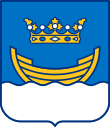
Helsinki is the capital, primate, and most populous city of Finland. Located on the shore of the Gulf of Finland, it is the seat of the region of Uusimaa in southern Finland, and has a population of 658,864. The city's urban area has a population of 1,268,296, making it by far the most populous urban area in Finland as well as the country's most important center for politics, education, finance, culture, and research; while Tampere in the Pirkanmaa region, located 179 kilometres (111 mi) to the north from Helsinki, is the second largest urban area in Finland. Helsinki is located 80 kilometres (50 mi) north of Tallinn, Estonia, 400 km (250 mi) east of Stockholm, Sweden, and 300 km (190 mi) west of Saint Petersburg, Russia. It has close historical ties with these three cities.

Kankaanpää is a town and municipality of Finland. Kankaanpää was founded in 1865, became a township in 1967 and finally a town in 1972. It is located in the crossroads of Hämeenkangas and Pohjankangas ridges. It belongs to the region of Satakunta. Kankaanpää has a population of about 12,700 inhabitants, which make it the third largest municipality in the Satakunta region in terms of population, after the city of Pori and the town of Rauma. Pori is located 53 kilometres (33 mi) southwest of Kankaanpää.

Pasila is a part of Helsinki, Finland, that is both a central-northern neighbourhood and district, bordering the areas of Alppila to the south, the Central Park (Keskuspuisto) to the west, and Vallila to the east.

Tamminiemi is a villa and house museum located in the Meilahti district of Helsinki, Finland. It was one of the three official residences of the President of Finland, from 1940 to 1982. From 1956, until his death, it served as the residence of President Urho Kekkonen. Since 1987, it has been the Urho Kekkonen Museum. Tamminiemi is located in a park by the sea. It's floor area is about 450 square metres (4,800 sq ft); living quarters comprise the first two floors while the third floor is dedicated to office space.
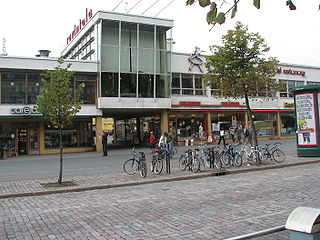
Lasipalatsi is a functionalist office building designed in the 1930s, located on Mannerheimintie in the Kamppi district of Helsinki, Finland. Lasipalatsi is one of Helsinki's most notable functionalist buildings.
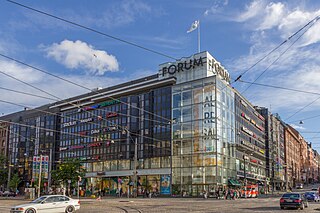
Forum is a shopping centre in Helsinki, Finland, opened in 1985 and located between the streets of Mannerheimintie, Simonkatu, Yrjönkatu and Kalevankatu.
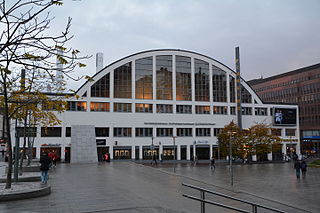
Helsinki Art Museum, abbreviated as HAM, is an art museum in Helsinki, Finland. It is located in Tennispalatsi in Kamppi. The museum reopened after renovations and rebranding in 2015.

Luckan is a network of Finland-Swedish cultural centres in Finland. Currently, there are located in 11 cities and towns in Finland: Helsinki, Kimito in Kimitoön, Kirkkonummi, Kokkola, Kristinestad, Närpes, Porvoo, Karis in Raseborg, Tampere, Turku and Oulu.

Guggenheim Helsinki Plan was an initiative to establish a Guggenheim museum in Helsinki, Finland. A proposal was introduced to the Helsinki City Council in 2011. After rejection of the initial plan in 2012, a new plan, introduced in 2013, was considered and finally rejected in 2016.
The following is a timeline of the history of the city of Helsinki, Finland.
Föreningen Konstsamfundet is a Finnish association with the goal of supporting the culture of the Swedish-speaking minority of Finland. It was founded in 1940 by vuorineuvos Amos Anderson, a newspaper publisher and a patron of the arts who bequeathed his entire fortune to Konstsamfundet.

JKMM Architects is a Finnish architectural firm. Asmo Jaaksi, Teemu Kurkela, Samuli Miettinen and Juha Mäki-Jyllilä established JKMM Architects in 1998. They started their studies in the middle of eighties. From the beginning, architectural innovation has been the driving force of their work. Studio's design approach reflects Scandinavian values and aesthetics. Their goal is to make architecture with exceptional architectural and technical quality. Over the years JKMM has grown and it employs over 80 professionals. They operate actively in various areas and scales of architecture designing buildings, interiors, furniture, urban environments as well as renovations.

The Helsinki Central Library Oodi, commonly referred to as Oodi, is a public library in Helsinki, Finland. The library is situated in the Kluuvi district, close to Helsinki Central Station and next to Helsinki Music Centre and Kiasma Museum of Contemporary Art. Despite its name, the library is not the main library in the Helsinki City Library system, which is located in Pasila instead.

Amos Valentin Anderson was the owner of Finland's largest Swedish-language newspaper, Hufvudstadsbladet, and a patron of the arts.

Villa Karo is a Finnish-African culture center and artist residence in the coastal village of Grand-Popo, Benin. Its purpose is to build a bridge between Finnish and African artists and cultural figures. The primary task is to offer a possibility to reside in Africa for Finnish artists, researchers, teachers and other professionals in cultural and social fields. In addition, African professionals in culture are encouraged to visit Finland.

The COVID-19 pandemic in Finland has resulted in 1,405,255 confirmed cases of COVID-19 and 7,448 deaths.
Suohpanterror is a Finland-based Sámi art and activist group. It includes a group of anonymous artists from Finland, Norway, and Sweden, producing memes and other visual arts distributed largely via social media, posters, and performance art. Suohpanterror describes its work as "artivism" with a focus on resisting "colonization and environmental injustice in Sápmi."
Pentik Oy is a Finnish family owned company specialized in ceramics and interior decoration. It was founded by Anu Pentik and Topi Pentikäinen in 1971. The Pentik brand of the company focuses on textiles and ceramics.
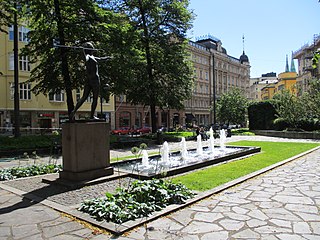
Kolmikulma, also known as the Diana Park, is a small, rectangular triangular-shaped park located in the Kaartinkaupunki district in the city center of Helsinki, Finland. It is limited by the Yrjönkatu, Uudenmaankatu and Erottajankatu streets. The park was renovated in 2006 and 2007.
Bad Bad Boy is a pink sculpture made of concrete in Jätkäsaari, Helsinki, Finland. The sculpture was created by sculptor Tommi Toija and represents a naked urinating boy. The sculpture is 8.5 metres (28 ft) tall and weighs seven and a half tons. The water flow in the sculpture is heated so the boy can urinate all year round, even in winter. The sculpture was made of spray concrete around a steel frame and was made in Sweden.






















